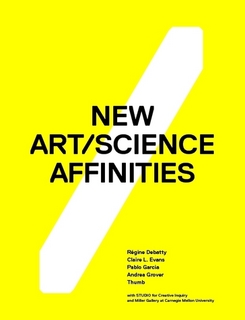Jacques Khalip, Robert Mitchell (eds.): Releasing the Image: From Literature to New Media (2011)
Filed under book | Tags: · acoustics, aesthetics, art, audiovisual, biopolitics, cinema, critique, image, literature, new media, new media art, phenomenology, philosophy, photography, sound recording, theory, video

“It has become a commonplace that “images” were central to the twentieth century and that their role will be even more powerful in the twenty-first. But what is an image and what can an image be? Releasing the Image understands images as something beyond mere representations of things. Releasing images from that function, it shows them to be self-referential and self-generative, and in this way capable of producing forms of engagement beyond spectatorship and subjectivity. This understanding of images owes much to phenomenology—the work of Husserl, Heidegger, and Merleau-Ponty—and to Gilles Deleuze’s post-phenomenological work. The essays included here cover historical periods from the Romantic era to the present and address a range of topics, from Cézanne’s painting, to images in poetry, to contemporary audiovisual art. They reveal the aesthetic, ethical, and political stakes of the project of releasing images and provoke new ways of engaging with embodiment, agency, history, and technology.”
With contributions by Peter Geimer, Jean-Luc Marion, Giorgio Agamben, Mark B.N. Hansen, Vivian Sobchack, Timothy Murray, Cesare Casarino, Kenneth Surin, Forest Pyle, Kevin McLaughlin, Bernard Stiegler
Publisher Stanford University Press, 2011
ISBN 0804761388, 9780804761383
304 pages
PDF (updated on 2019-10-7)
Comments (2)Grover, Debatty, Evans, Garcia, Thumb: New Art/Science Affinites (2011)
Filed under sprint book | Tags: · art, bio art, biotechnology, hacking, maker culture, media art, programming, science, subversion, technology

The Miller Gallery at Carnegie Mellon University and the STUDIO for Creative Inquiry have co-published “New Art/Science Affinities,” a 190-page book on contemporary artists that was written and designed in one week by four authors (Andrea Grover, Régine Debatty, Claire Evans and Pablo Garcia) and two designers (Luke Bulman and Jessica Young of Thumb).
“New Art/Science Affinities,” which focuses on artists working at the intersection of art, science and technology, was produced by a collaborative authoring process known as a “book sprint.” Derived from “code sprinting,” a method in which software developers gather in a single room to work intensely on an open source project for a certain period of time, the term book sprint describes the quick, collective writing of a topical book.
The book includes meditations, interviews, diagrams, letters and manifestos on maker culture, hacking, artist research, distributed creativity, and technological and speculative design. Chapters include Program Art or Be Programmed, Subvert! Citizen Science, Artists in White Coats and Latex Gloves, The Maker Moment and The Overview Effect.
Sixty international artists and art collaboratives are featured, including Agnes Meyer-Brandis, Atelier Van Lieshout, Brandon Ballengée, Free Art and Technology (F.A.T.), Rafael Lozano-Hemmer, The Institute for Figuring, Aaron Koblin, Machine Project, Openframeworks, C.E.B. Reas, Philip Ross, Tomás Saraceno, SymbioticA, Jer Thorp, and Marius Watz.
The authors collectively wrote and designed the book during seven, 10-14 hour-days in February 2011 at the STUDIO for Creative Inquiry. During their sessions they held conversations with CMU faculty, staff and students from the STUDIO, Miller Gallery, College of Fine Arts, Robotics Institute, Machine Learning Department and BXA Intercollege Degree Program.
“The book sprint method was adopted in order to understand this very moment in art, science and technology hybrid practices, and to mirror the ways Internet culture and networked communication have accelerated creative collaborations, expanded methodologies, and given artists greater agency to work fluidly across disciplines,” says lead author Andrea Grover.
The publication is part of Grover’s Andy Warhol Foundation for the Visual Arts Curatorial Research Fellowship at CMU’s STUDIO for Creative Inquiry and Miller Gallery. “Intimate Science,” an exhibition that will be the product of Grover’s research, will take place in early 2012 at the Miller Gallery.
Published by Miller Gallery at Carnegie Mellon University + CMU STUDIO for Creative Inquiry, October 2011
ISBN 0977205347
190 pages
Licensed under Creative Commons Attribution-NonCommercial-NoDerivs 3.0 License
commentary (We-Make-Money-Not-Art.com)
authors
Paulo Freire: Pedagogy of the Oppressed (1968/2000)
Filed under book | Tags: · critical consciousness, critical pedagogy, democracy, education, pedagogy, society

First published in Portuguese in 1968, Pedagogy of the Oppressed was translated and published in English in 1970. The methodology of the late Paulo Freire has helped to empower countless impoverished and illiterate people throughout the world. Freire’s work has taken on especial urgency in the United States and Western Europe, where the creation of a permanent underclass among the underprivileged and minorities in cities and urban centers is increasingly accepted as the norm. With a substantive new introduction on Freire’s life and the remarkable impact of this book by writer and Freire confidant and authority Donaldo Macedo, this anniversary edition of Pedagogy of the Oppressed will inspire a new generation of educators, students, and general readers for years to come.
Originally published in Portuguese in 1968; First English edition in 1970
Translated by Myra Bergman Ramos
With an Introduction by Donaldo Macedo
30th Anniversary Edition
Publisher Continuum International Publishing Group, New York, 2000
ISBN 0826412769, 9780826412768
183 pages
book page
wikipedia
publisher
google books
PDF (updated on 2012-3-30)
Comments (3)
